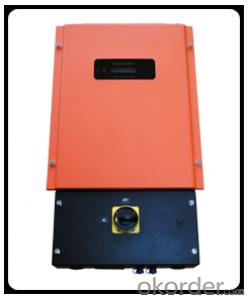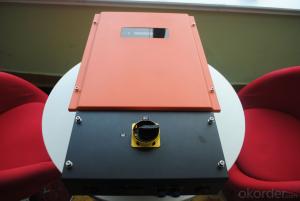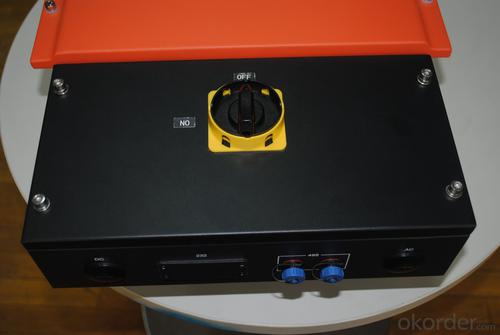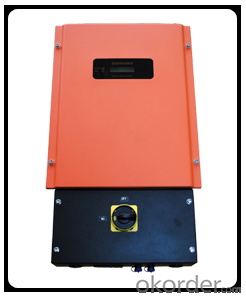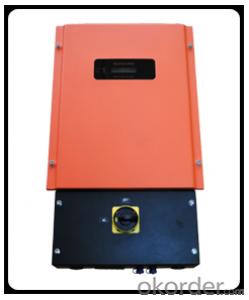3.6 Kw Solar Inverter Sunteams 4000-5000 (US) ETL with Wirebox
- Loading Port:
- Shanghai
- Payment Terms:
- TT OR LC
- Min Order Qty:
- 5 watt
- Supply Capability:
- 3000 watt/month
OKorder Service Pledge
OKorder Financial Service
You Might Also Like
The Sunteams (US) 1500 ~5000 series isapplicable to various rooftops and small scale photovoltaic grid connected power plants. Their nominal output powers are 1.5 kW, 2 kW, 2.5 kW, 3 kW, 4 kW and 5kW respectivelywith Certificate ETL (220V/60HZ).
This series is transformerless and has a wide range of MPPT input voltage. Itsmaximum conversion efficiency and MPPT tracking accuracy reach 97.6 % and 99.5% respectively. The maximum DC voltage reaches 550 V. Its multilingualLCD display facilitates easy operation. It has waterproof direct plug interminals. It has overvoltage, islanding, short circuit, overloading andoverheating protection functions. Its IP65 protection degree will ensure itruns well in various tough environments.
These units are available with wirebox (DC Switch).
UL certified
■ For countries with UL certification (UL 1741 / IEEE 1547)
Efficient
■ The CEC efficiency of the inverter can reach 95.0 %-97.5 %
■ Transformerless desi
Simple
■ ‘Plug and play’connection for easy installation and maintenance
■ Designed for hanging with simple and easy installation
■ Fanless cooling concept
Communicative
■ RS232/RS485 interfaces as standard
■ Optional Bluetooth technology
- Q: How does shading impact the performance of a solar inverter?
- Shading has a significant impact on the performance of a solar inverter. When even a small portion of a solar panel is shaded, it can drastically reduce the overall power output. This is because shading disrupts the flow of sunlight, causing a drop in voltage and current production. Consequently, the solar inverter's performance is compromised as it relies on a consistent and unobstructed energy supply from the solar panels. To mitigate the effects of shading, techniques like bypass diodes or micro-inverters are employed to minimize the impact of shading on the overall solar system performance.
- Q: How efficient are solar inverters?
- Solar inverters are highly efficient, with most modern models achieving efficiency levels of 95% or higher. This means that they can convert a significant amount of the DC power generated by solar panels into usable AC power for homes and businesses, minimizing energy losses and maximizing the overall efficiency of the solar system.
- Q: What are the safety certifications to look for in a solar inverter?
- Some safety certifications to look for in a solar inverter include UL 1741, IEC 62109, and CSA C22.2 No. 107.1. These certifications ensure that the inverter meets specific safety standards, such as protection against electrical shocks, fire hazards, and grid disturbances. It is essential to check for these certifications to ensure the safe and reliable operation of the solar inverter.
- Q: Can a solar inverter be used with a solar air conditioning system?
- Yes, a solar inverter can be used with a solar air conditioning system. A solar inverter is responsible for converting the direct current (DC) power generated by solar panels into alternating current (AC) power that can be used to operate electrical appliances. Solar air conditioning systems typically require AC power to function, so a solar inverter would be necessary to convert the DC power from the solar panels into the AC power needed for the air conditioning system.
- Q: What is the role of a grid monitoring feature in a solar inverter?
- The role of a grid monitoring feature in a solar inverter is to constantly monitor the electrical grid for voltage, frequency, and other parameters. This feature ensures that the solar inverter is synchronized with the grid and operates within the specified limits. It helps in maintaining a stable and reliable connection between the solar system and the grid, preventing any damage to the inverter or the grid. Additionally, grid monitoring also enables the solar inverter to detect any faults or abnormalities in the grid and take appropriate measures to protect the system and ensure safe operation.
- Q: What is the maximum DC input current that a solar inverter can handle?
- The maximum DC input current that a solar inverter can handle varies depending on the specific model and capacity of the inverter. It is typically mentioned in the product specifications and can range from a few amps to several hundred amps.
- Q: What is the power factor of a solar inverter?
- The power factor of a solar inverter refers to the ratio between the real power and the apparent power. It indicates how effectively the inverter converts the DC power generated by solar panels into AC power. A high power factor (close to 1) indicates efficient power conversion, while a low power factor (close to 0) signifies poor conversion efficiency.
- Q: What are the key considerations for selecting a reliable solar inverter manufacturer?
- When selecting a reliable solar inverter manufacturer, key considerations include the manufacturer's reputation and experience in the industry, the quality and reliability of their products, the efficiency and performance of their inverters, the warranty and after-sales support provided, the compatibility of their inverters with your specific solar system requirements, and the manufacturer's financial stability and longevity in the market. Additionally, checking customer reviews and feedback can provide valuable insights into the manufacturer's track record and customer satisfaction.
- Q: What is the temperature range for optimal operation of a solar inverter?
- The temperature range for optimal operation of a solar inverter is typically between -20°C to 50°C.
- Q: How does a solar inverter handle voltage flicker in the grid?
- A solar inverter handles voltage flicker in the grid by continuously monitoring the grid voltage. When it detects a flicker, it adjusts its output power accordingly to stabilize the voltage and maintain a consistent power supply to the connected loads. This helps prevent disruptions and ensures a smooth operation of the grid.
Send your message to us
3.6 Kw Solar Inverter Sunteams 4000-5000 (US) ETL with Wirebox
- Loading Port:
- Shanghai
- Payment Terms:
- TT OR LC
- Min Order Qty:
- 5 watt
- Supply Capability:
- 3000 watt/month
OKorder Service Pledge
OKorder Financial Service
Similar products
Hot products
Hot Searches
Related keywords

